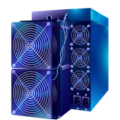Asic Miner Profitability
Our mining profitability calculator helps users quickly pinpoint the most lucrative mining options by delivering real-time data in multiple fiat and cryptocurrency currencies, including USD, EUR, GBP, AED, CAD, AUD, THB, ETH, and BTC. It allows precise electricity cost inputs up to three decimal places for highly accurate profit estimations. Users can access a clear overview of top-performing miners, algorithm-specific performance tables, and visually organized listings of mineable coins with recognizable cryptocurrency icons, simplifying decisions for maximum returns.
| Model | Hashrate |
Profitability
Profit
|
|---|---|---|
|
Bitmain Antminer KS7
40TH/s
|
40 TH/s |
$4.67/day
|
|
IceRiver KS7
30TH/s
|
30 TH/s |
$1.22/day
|
|
IceRiveR KS7 Lite
4.2TH/s
|
4.2 TH/s |
$0.15/day
|
|
IceRiver KS0 Ultra
400GH/s
|
400 GH/s |
$-0.09/day
|
|
IceRiver KS0
100GH/s
|
100 GH/s |
$-0.10/day
|
|
IceRiver KS0 PRO
200GH/s
|
200 GH/s |
$-0.14/day
|
|
IceRiver KS2 Lite
2TH/s
|
2 TH/s |
$-0.43/day
|
|
Goldshell KA Box
1.18TH/s
|
1.18 TH/s |
$-0.46/day
|
|
Bitmain Antminer KS5
20TH/s
|
20 TH/s |
$-0.47/day
|
|
Bitmain Antminer KS5 PRO
21TH/s
|
21 TH/s |
$-0.49/day
|
|
Goldshell KA Box PRO
1.6TH/s
|
1.6 TH/s |
$-0.73/day
|
|
IceRiver KS1
1TH/s
|
1 TH/s |
$-0.89/day
|
|
IceRiver KS2
2TH/s
|
2 TH/s |
$-1.77/day
|
|
Goldshell E-KA1M
5.5TH/s
|
5.5 TH/s |
$-2.00/day
|
|
IceRiver KS5M
15TH/s
|
15 TH/s |
$-2.56/day
|
Our cutting-edge mining calculator offers comprehensive insights across all major cryptocurrency algorithms, helping users easily identify the most profitable options for their specific hardware. The algorithm data is continuously refreshed to keep pace with the dynamic crypto mining industry, providing accurate evaluations based on real-time profitability statistics and overall market activity. This empowers users to make well-informed choices that reflect the latest mining conditions and algorithm performance.
Bitcoin Mining Difficulty
Monitor the latest Bitcoin network difficulty metrics in real time, including block times & estimated time until the next difficulty adjustment.
Progress
Current progress:
61.51 %
Remaining Block
Blocks Left:
776
Remaining Time
Time Left:
~ 5 days 1 hours
Next Change
Upcoming change:
6.9 %
Block Time
Current Block Time:
9.4 minutes
What is KHeavyHash algorithm?
Why Should You Rely on Our Profit Calculator for Accurate Mining Insights?
kHeavyHash powers Kaspa with a proof-of-work core that fuses dense matrix multiplication with two Keccak operations. It preserves cryptographic integrity through Keccak. The scheme targets high throughput and near‑instant block emission, so the ledger moves with one‑second heartbeats. Its workload leans on arithmetic rather than memory, which lowers VRAM pressure and suits both GPUs and FPGAs. Early miners favored commodity cards, yet the modest memory footprint invited specialized silicon. Purpose‑built ASICs arrived and pushed network hashrate sharply higher, along with efficiency per joule on that class of hardware. The same design can draw more power than SHA‑256 on comparable setups because the matrix stage is compute heavy. Energy per confirmation can still compare well when rapid blocks compress waiting time. Results also depend on hardware and settings. kHeavyHash was not crafted to resist ASICs, which shapes decentralization by tilting rewards toward operators with access to new rigs. Security leans on Keccak primitives and the determinism of its linear algebra. Kaspa organizes blocks in a directed acyclic graph, so parallel additions reduce orphaning and support high bandwidth without long delays. Frequent client and miner optimizations refine scheduling, arithmetic kernels, and networking, which helps stabilize latency and improve utilization. FPGA implementations benefit from the regular structure of the matrix step, and many designs stream operands to keep power spikes in check. The result is an algorithm that is austere in memory, exuberant in computation, and alive to the trade between speed, hardware diversity, and the ever‑shifting center of gravity in mining.
Latest ASIC Miners
Check out the latest ASIC miners added to our site. These are the newest listings, featuring the most recent models.
V3
Nerdminer
AE3
IceRiver
Antminer L11 Hyd 2U
Bitmain
Why ASIC Mining?
The Advantages of ASIC Mining Compared to Other Mining Types
ASIC (Application-Specific Integrated Circuit) mining involves specialized hardware designed exclusively for mining cryptocurrencies like Bitcoin, offering unmatched efficiency and performance. Unlike general-purpose GPUs, ASICs are optimized for specific algorithms, delivering significantly higher hashrates while consuming less power per hash. This makes them far superior for mining tasks, as they maximize profitability by reducing electricity costs and increasing mining output. ASIC miners are purpose-built, providing stability and reliability in high-demand mining environments, unlike GPUs which are prone to overheating and wear during prolonged use. Their compact design also allows for easier scalability in large mining operations. By focusing solely on mining, ASICs eliminate the overhead of multi-purpose computing, resulting in faster block-solving times. This efficiency translates to higher rewards, making ASICs the preferred choice for serious miners aiming to stay competitive in the cryptocurrency market. In contrast, GPU mining, while versatile, cannot match the raw power and cost-effectiveness of ASICs for dedicated mining tasks.
Optimized for Mining
Energy Efficient
Reliable & Stable
Scalable
More about the KHeavyHash algorithm
See how our profit calculator delivers accurate, real-time mining insights, helping miners make informed decisions.
Begin at the present, where specialized machines hum with purpose, and trace backward through the mirrors of memory to the algorithm that set the tempo: kHeavyHash, a proof-of-work scheme crafted for Kaspa that interleaves compact matrix multiplication with two Keccak-based hashing steps, leveraging the cryptographic core underlying SHA-3 to deliver strong diffusion while keeping video memory demands unusually low, so early on even modest GPUs and FPGAs could participate efficiently; by leaning on compute rather than large datasets, it avoided the memory bottlenecks that sideline smaller miners in other protocols and enabled dual mining on GPUs, where Kaspa could be run alongside more memory-bound coins to squeeze extra utility from the same hardware, yet the very clarity of its design-never intended to resist ASICs-ultimately invited purpose-built devices that increased network hashrate and security but shifted the mining landscape away from broad GPU accessibility and toward professional operations, raising familiar questions about decentralization; energy-wise, its compute-heavy character means higher power draw per device compared with the highly optimized ASIC ecosystems of algorithms like SHA-256, even as it remains efficient for its class by keeping data movement minimal and arithmetic dense in registers and cache; on-chain, Kaspa’s one-second block cadence and blockDAG architecture, orchestrated by the GHOSTDAG ordering protocol, let multiple blocks be added concurrently with low orphaning, producing steady reward flow, seconds-level confirmation, and markedly higher throughput without the latency penalties that haunt linear chains, characteristics well-suited to applications that need rapid settlement and high resiliency under load; for miners, this rhythm translates into fast block discovery, quick transaction verification, and tight response windows to new work, while practical planning is grounded in tools that estimate potential outcomes from hardware hashrate, power consumption, network difficulty, pool conditions, and expected uptime; taken together, Kaspa’s high-speed blockDAG and the compute-focused efficiency of kHeavyHash form a system engineered for throughput and responsiveness, one that began as a haven for lower-memory GPUs, matured with FPGA experimentation, and now runs at scale on ASICs, a cycle turning like a wheel as the network’s technical foundations continue to expand capacity and compress time between intent and confirmation.
 English
English
 German
German
 Hungarian
Hungarian
 Dutch
Dutch
 Spanish
Spanish
 French
French
 Italian
Italian
 Czech
Czech
 Polish
Polish
 Greek
Greek




















